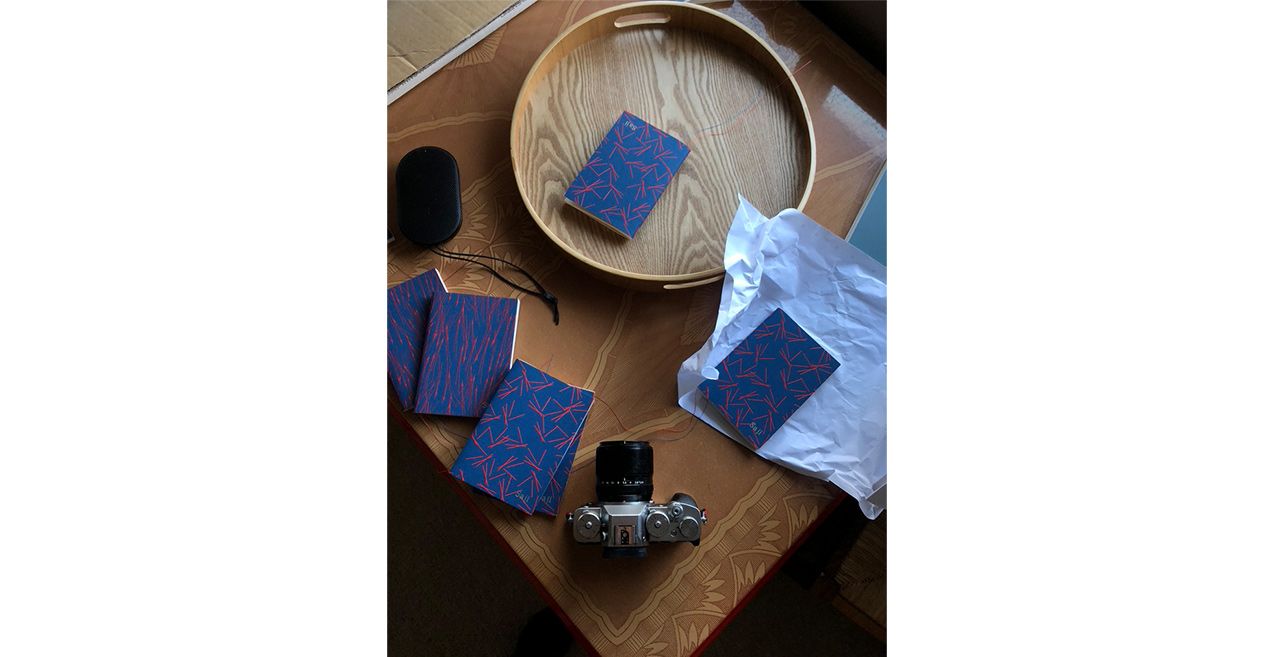It’s happy hour somewhere, they say¹.
Which means it also morning somewhere. And that somewhere is here, in my little corner window office (which just so happens to double as the corner of my bedroom), on Monday December 7th.
On Sunday morning (a day before my self-imposed Monday deadline), I quietly deployed The Workbench, my online shop for special projects involving writing and design, and launched my first product: Saji Notebooks (limited edition screen-printed art notebooks). If you read my last letter, you’ll know that this project has taken me nearly three years to publish. As with every other milestone thus far, the lead-up was a flurry of activity, but the launch itself was anti-climactic: disable the password, click the “deploy” button and then… silence. I went for a walk. Reflected. In the back of my mind, I think I was hoping for a moment of catharsis, a rush of jubilation, or some other kind of emotional payoff.
Instead, I just felt apprehensive. It feels good to have published, and I’m proud that I was able to simplify a project — that just a few weeks ago felt impossible — enough to launch it in just a week, but I know that my work is only half-done, and I am now officially in foreign territory now: I have to begin marketing.
This fills me with dread. At the burning center of The Resistance that caused me to delay finishing this project for three years is a voice: raspy, guttural, ugly, quietly mocking. It’s Jack Nicholson in Anger Management.
It says: "you’re not good enough". It whispers other mean permutations of this sentiment, but they are all the same. They assault confidence, they challenge faith, and marketing — the act of sharing your thing with the world and telling that world that it should definitely buy that thing from you because your thing is worthy — is the ultimate test of confidence. It is in these moments that Jack Nicholson rears his balding head and rasps: “you’re not good enough.”
It is precisely at these moments when ignoring Jack Nicholson is of the utmost importance.
So, without any expectation or fanfare, I plan to begin pestering my social networks. My intention is to do this just a few times in December, as non-obnoxiously as I can, on both Facebook and Instagram.
I may also attempt to set up some targeted ads on these platforms to try and spread the word out-of-network. This is appealing because I know exactly the types of people who will adore these notebooks. To be reductive: they are people like me.
These platforms seem like good places to deliver highly specific ads, and based on my (very) limited understanding, it seems reasonable to expect that, armed with a clear psychographic picture of a customer, I can buy placements that are cost-effective and convert well.
Of course, if it were that easy we would all be social media ad moguls, so I’m assuming that I am at least 85% wrong.

Book learnings
As for the last week of effort, a few things I learned, in no particular order:
Shopify makes some things unexpectedly easy (setting up ToS, Legal pages, etc) and some things unexpectedly difficult (customizing sale price styling). I also had to budget extra time for things that I didn’t even have on my roadmap, like configuring shipping zones and finding answers to a few esoteric legal questions.
Shipping fulfillment and the (Canadian) postal service are highly arcane. It appears to cost me less to ship to the other side of the continent (via airplane) than it does to ship to my own address.
Payment processing is equally inscrutable, and I am thankful for Shopify’s turn-key payment architecture. Both from a development standpoint and an operational standpoint, it was nice to just be able to trust that their basic system would work without any complex intervention or set-up (they even have a “bogus” payment gateway that I used to test the system before launch).
I “user tested” the product narrative and photography (on the product page itself) on a few friends before launching. This turned out to be a valuable exercise as there were a few things that people didn’t understand, and a few areas where I was (as usual) too verbose. The most encouraging piece of feedback I received? “By the time I finished reading the story I wanted to buy one.”
You may remember that I had planned to sell each of these books for a whopping $53 each. You may also remember that my margin on that price (after factoring in the costs of producing and selling them) was quite low. After thinking about it, I decided to set the price at $63 instead, which gives me a little wiggle-room to offer discounts to friends and family and things like free shipping during the holidays. For those who love these books enough to spend $53 on them, an extra $10 probably won’t be an insurmountable hurdle — and, while $60 is a lot to spend on a consumable item — it’s no greater than the price of dinner and drinks on a Saturday evening.
The product description and narrative, which took a few drafts to get right, are featured on the product pages. I wanted to acknowledge the ridiculous amount of thought, work, and attention that went into creating these without going overboard on detail fetish. Although I don't love the single long column of text on that page, I had to resist the impulse to play with the styling/layout. Any unnecessary visual design flourishes felt dangerous to me given my impending deadline.
From the product page:
Each cover is cut from a single, limited edition A4 screen-print, foil stamped, and thread-bound to 40 signatures (80 pages) of premium recycled pulp-fiber writing paper. Cover designs are based on old textile motifs discovered in a Heian-era Shingon buddhist monastery in Southern Japan. The cover paper has been carefully selected to highlight unique artefacts and inconsistencies of hand-printing, and to wear down uniquely with age, just like your favourite pair of jeans.
I'm also including a printed copy of the story with each book for those who want to give them as gifts. The opening passage:
For most of our lives, objects come and go like trade winds without any real lasting effect. We buy impulsively, thoughtlessly, emotionally, and then our things, once objects of such feverish attentions, simply fade into the background of diurnal existence, landscape that we speed by heedlessly on the great freeway of life. But every once in a long while, something surfaces in the fog for some peculiar reason.
You can read the rest here.
I have a few, super limited-edition (3 or 4) cover prints in original A4 format, which I'm going to frame and add to the site as well.
And that’s it. I’ll launch ads this week, ship a few books (with any luck) next week, and then — some much needed rest and recovery. I’m working on a few essays, but I’m not going to kill myself to finish anything else this month.
If any of you would like to purchase a book, you can use the code FRIENDSOFSAJI at checkout for 15% off, in addition to the free shipping for the next week.
Happy December,
-S
Did you enjoy this?
Subscribe to The Night Letters to get occasional newsletters about creative invention and entrepreneurship
